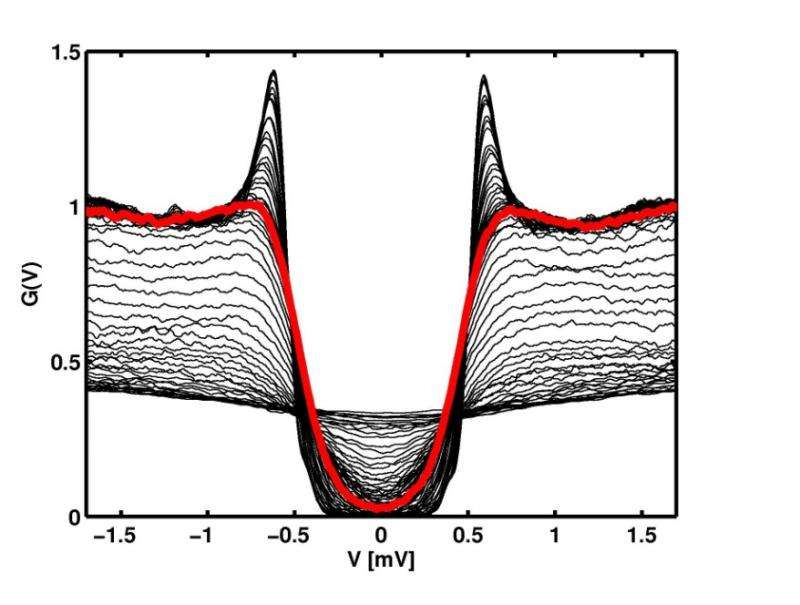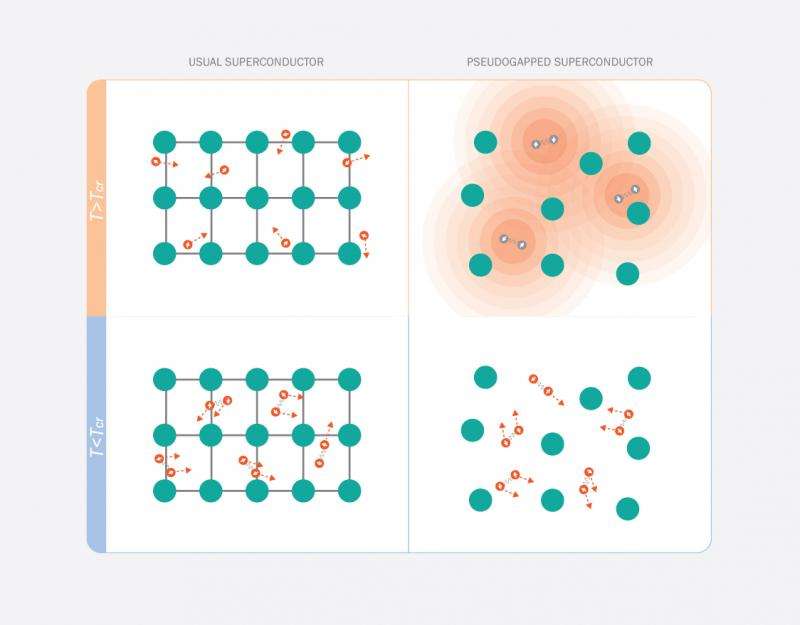Physicists explain the unusual behavior of strongly disordered superconductors

In the paper published by the scientists in Physical Review B: Condensed Matter And Materials Physics, they discuss so-called pseudogapped superconductors.
Physicists Mikhail Feigel'man (the head of MIPT's theoretical nanophysics laboratory) and Lev Ioffe have explained the unusual effect in a number of promising superconductor materials. Using a theory they developed previously, the scientists have linked superconducting carrier density with the quantum properties of a substance.
The term "gap" appears in the quantum theory of superconductivity and is a definition for the characteristic gap in an electron energy distribution diagram, the energy spectrum. A distinction is made between superconductors with a "conventional" gap and special superconductors, which, even in their normal state, demonstrate something similar to a gap – it is called a "pseudogap."
Electron pairs and superconductivity
In order to understand what a "gap" is, we need to look briefly at the theory behind the term. At present, there is no complete model able to explain the phenomenon of superconductivity in full detail (and which would enable us, for example, to synthesize a superconductor capable of working at room temperature). However, one successful model that is most often used today is the BCS theory, which was developed by John Bardeen, Leon Cooper, and John Robert Schrieffer.
In BCS theory, a key role is played by Cooper pairs – two electrons bound together with opposite spins. On the one hand, these pairs are characterized by a very weak bond between the particles, which is purely of a quantum nature – in classical theory, electrons have the same charge and should repel one another. On the other hand, they do not interact with the crystal lattice and therefore move freely within a substance and do not lose energy in collisions. If a metal is cooled to a temperature at which the thermal motion of particles does not prevent the formation of Cooper pairs, these pairs can be made to move without loss of energy and thus cause the whole specimen to reach its superconducting state.
The formation of Cooper pairs alters not only the electrical properties of a substance as a whole, but also electron energy distribution—the energy spectrum. The coupling of the pairs results in a characteristic gap, or pseudogap depending on the circumstances. If the substance is a superconductor, and after cooling to critical temperature superconductivity was reached at the same time as the formation of the Cooper pairs, it is called a gap. However, if this occurs in the electron spectrum diagram after cooling, but superconductivity has not yet been reached, the term "pseudogap" is used (meaning it is not a "true" gap, and its formation is not linked to the onset of superconductivity). If this substance is cooled further, it will become a superconductor and the gap in its spectrum will increase – its value will include both the pseudogap and the superconducting gap itself. The properties of these superconductors are considerably different to those of conventional superconductors.
Superconductors with a normal gap fit in well with the BCS theory, which explicitly links Cooper pairs with the formation of a gap in an energy distribution diagram. According to this theory, superconducting current density is directly proportional to the magnitude of the superconducting gap: ρs ~ Δ, the more Cooper pairs formed per unit volume, the larger the gap in the energy spectrum, i.e. the size of the gap.

Superconductors with a pseudogap do not fit in with the BCS theory, but they can be described using the theory proposed earlier by Mikhail Feigel'man and Lev Ioffe and their colleagues. In their new paper, the scientists used their theory to calculate the dependence of superconducting current density on pseudogap width for a pseudogapped superconductor.
The key is in the disorder
Studying the structure of pseudogapped superconductors at microscopic level showed that these materials are strongly disordered. This means that their atoms are not arranged in a perfect crystal lattice, or the structure of this lattice is strongly impaired. Examples of pseudogapped superconductors given by the authors of the new paper are thin films of titanium nitride (in which the crystal lattice is impaired in many places) and indium oxide (which can be completely amorphous, like glass).

Disorder plays a key role because the transition to a superconducting state does not happen at the same time as the formation of Cooper pairs. The electrons that are bound to each other in these materials appear before electrical resistance disappears, because the numerous variations in the substance's microscopic structure from the ideal order can impede a Cooper pair, which in ordered crystals would move freely without interference.
It should be emphasized that Cooper pairs in a pseudogapped superconductor cannot be described as motionless. As a result of quantum effects, their behaviour is slightly more complex—obeying the uncertainty principle, they do not freeze motionless in one place, but "spread out" over a rather large (dozens of interatomic distances), but finite region. If they could move, this region would cover the entire substance.
Conclusion
Deducing electrical parameters of pseudogapped superconductors from quantum properties is important both from a fundamental point of view (scientists are beginning to have a better general understanding of superconductors), and a practical point of view. The researchers note that using indium oxide, a typical pseudogapped superconductor, it is already possible to create a superconducting quantum device that can be used as a prototype component for a quantum computer.
Having considered the movement of Cooper pairs in a substance with varying degrees of disorder, the scientists deduced the theoretical dependence of the density of Cooper pairs ρs in the substance on pseudogap width. This is an important characteristic, as it is inversely proportional to the inductance of the film (the materials described are obtained in film form) in the superconducting state. Films such as this, with high inductance and zero resistance, are needed to produce qubits, the fundamental units of quantum computing devices.
In conventional superconductors, the dependence of the density of Cooper pairs on pseudogap width is linear (ρs ~ Δ). However, in the test substances the dependence is squared (ρs ~ Δ2). This fact is easy to verify experimentally in a more detailed study, and, if that happens, the theory developed previously by the authors will receive further confirmation.
Provided by Moscow Institute of Physics and Technology




















